Fine motor skills are essential for kids’ overall development, particularly when it comes to writing, self-care, and daily activities. One critical aspect of fine motor development is the pincer grasp—the ability to hold objects between the thumb and index finger.
This skill typically begins to emerge around nine to twelve months of age and continues to refine as kids grow.
As a former preschool teacher with a Master’s in Education specializing in early childhood development, I have witnessed firsthand the importance of fostering this skill through play and daily life activities.
In this post, I’ll explore various pincer grasp activities that can help babies and toddlers develop this crucial motor skill.
In this post:
- Understanding the Pincer Grasp
- The Developmental Stages of the Pincer Grasp
- Why Pincer Grasp Development Matters
- Pincer Grasp Activities for Babies
- Pincer Grasp Activities for Toddlers
- Tips for Encouraging Pincer Grasp Development
We get commissions for purchases made through links in this post. As an Amazon Associate, we earn from qualifying purchases.
Understanding the Pincer Grasp
Before diving into specific activities, it’s essential to understand the pincer grasp and why it’s crucial.
The pincer grasp allows kids to pick up small objects, manipulate toys, and perform tasks that require precision, such as buttoning clothes or using utensils.
It involves the coordination of the thumb and index finger, working together to grasp and release objects.
Pincer grasp can be developed through play and by including kids in daily life activities like feeding and dressing. This skill will naturally grow when kids are given many opportunities to use their hands.
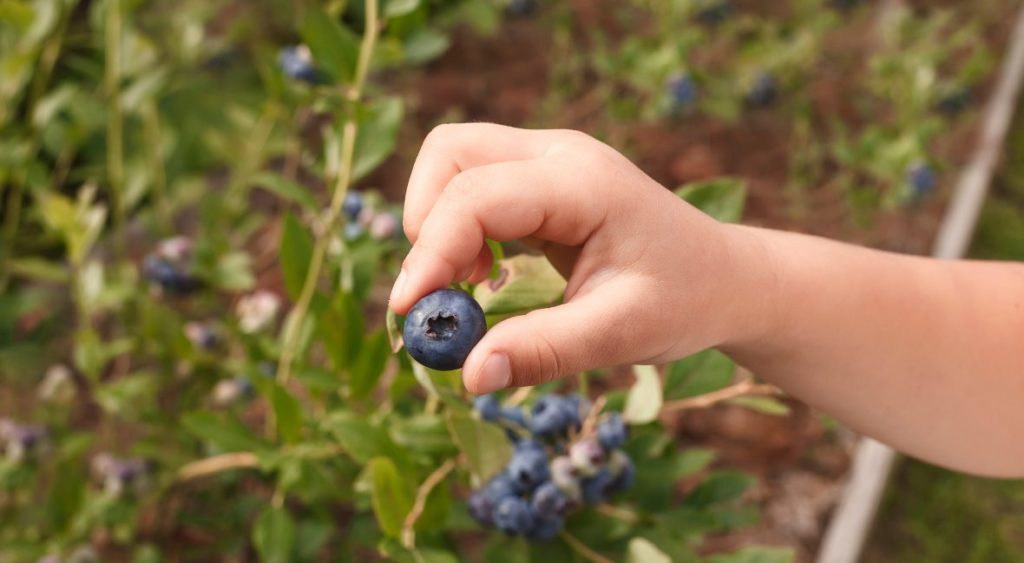
The Developmental Stages of the Pincer Grasp
- Raking Grasp (6-8 months): Babies use all fingers to rake objects toward themselves.
- Inferior Pincer Grasp (8-10 months): Babies start to use the pads of their thumb and index finger to pick up objects.
- Pincer Grasp (10-12 months): The thumb and index fingertips meet to grasp small objects precisely.
- Refined Pincer Grasp (12-18 months): The grasp becomes more refined and controlled, enabling more precise manipulation of objects.
Why Pincer Grasp Development Matters
Developing a solid pincer grasp is crucial for several reasons:
- Fine Motor Skills: Enhances the ability to perform tasks requiring dexterity, such as writing, drawing, and using scissors.
- Self-Care: Assists in daily activities like dressing, feeding, and grooming.
- Cognitive Development: Improves hand-eye coordination and problem-solving skills.
- Independence: Promotes self-reliance as kids learn to manage tasks on their own.
Engaging Pincer Grasp Activities
Here are some fun and practical activities to help kids develop and strengthen their pincer grasp.
Activities for Babies
1. Self Feeding
Allowing babies to feed themselves is an excellent way to develop their pincer grasp. They’re pretty motivated to try and get the food to their mouth!
You can learn more about self-feeding by checking out baby-led weaning.
- Materials Needed: finger foods, high chair with a foot plate (such as a Stokke Trip Trap)
- Activity: allow your baby to feed themselves at each meal
- Benefit: Enhances fine motor skills, independence, and positive relationships with food
2. Tissue Pulling
Babies love to pull on things – ever had a little one try to pull your hair?
Pulling tissues out of tissue boxes is fun and great for helping little ones practice grasping.
A reusable tissue box toy can save all your Kleenex from being wasted or eaten by babies!
- Materials Needed: Tissue box toy
- Activity: Allow babies to pull out each of the fabric tissues and practice pushing them back in
- Benefit: Develops hand strength and coordination
3. Turning Pages in a Book
Babies love to explore books, and board books allow them to practice turning the pages independently. Begin reading with your baby from birth to build strong positive associations with books.
- Materials Needed: Board books
- Activity: Encourage your child to explore books and to turn the pages one at a time
- Benefit: Improves fine motor skills and hand-eye coordination.
Check out all my favorite Montessori board books for toddlers!
4. Coin Box Toy
Putting coins through a slot is a simple way to work on finger, hand, and wrist control. Babies enjoy the challenge of slowly mastering this skill.
A simple coin box is perfect for little ones.
- Materials Needed: Coin box
- Activity: Slowly demonstrate how to pick up coins and place them into the box, and then allow your baby to practice
- Benefit: Develops finger dexterity and hand-eye coordination.
5. Finger Painting
Finger paints are the perfect introduction to painting for your little one. Paints are great for getting babies moving as they spread the paint around, and it often turns into full-body painting, not just finger painting!
I love to set up finger-painting activities on the floor and allow babies to explore and make a mess to their hearts’ content.
- Materials Needed: Finger paints (here’s a recipe for taste-safe finger paints) and finger painting paper
- Activity: Allow your child to use their fingers to make marks on the paper
- Benefit: Promotes fine motor skills, creativity, and sensory exploration
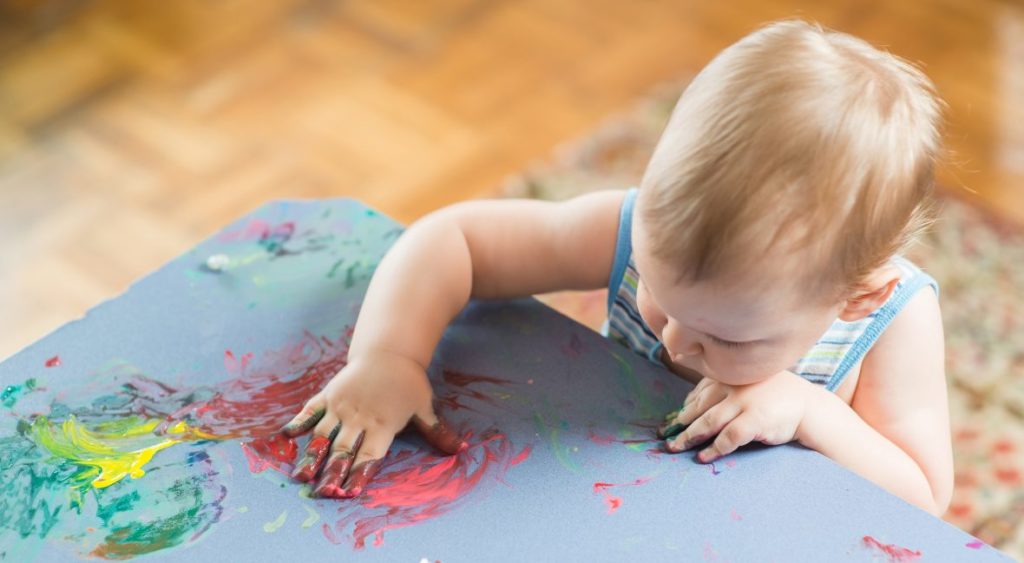
Activities for Toddlers
6. Picking Up Small Objects
Toddlers LOVE to put things into containers and take them out. This is a form of schematic play called containing.
Simply giving them access to a few buckets and containers with some small toys or loose parts can keep them engaged for long periods of time!
- Materials Needed: Large wooden beads, pom-poms, gems, rocks, or small toys, buckets or containers
- Activity: Scatter small objects on a flat surface and let your child collect and play with them however they would like
- Benefit: Enhances fine motor precision, hand-eye coordination, focus, and independent play skills
7. Peeling Stickers
Toddlers love to stick stickers. Stickers are an excellent activity for encouraging hand separation (or the use of thumb, pointer finger, and middle finger).
Sticker protip: Use dot labels instead of stickers. They’re much cheaper, and kids can stick as many as they like.
- Materials Needed: Stickers of various shapes and sizes, dot labels, paper
- Activity: Provide a sheet of stickers and a blank piece of paper and give kids lots of time to peel the stickers off and stick them onto the paper
- Benefit: Improves finger dexterity and control
Check out all my favorite sticker craft ideas.
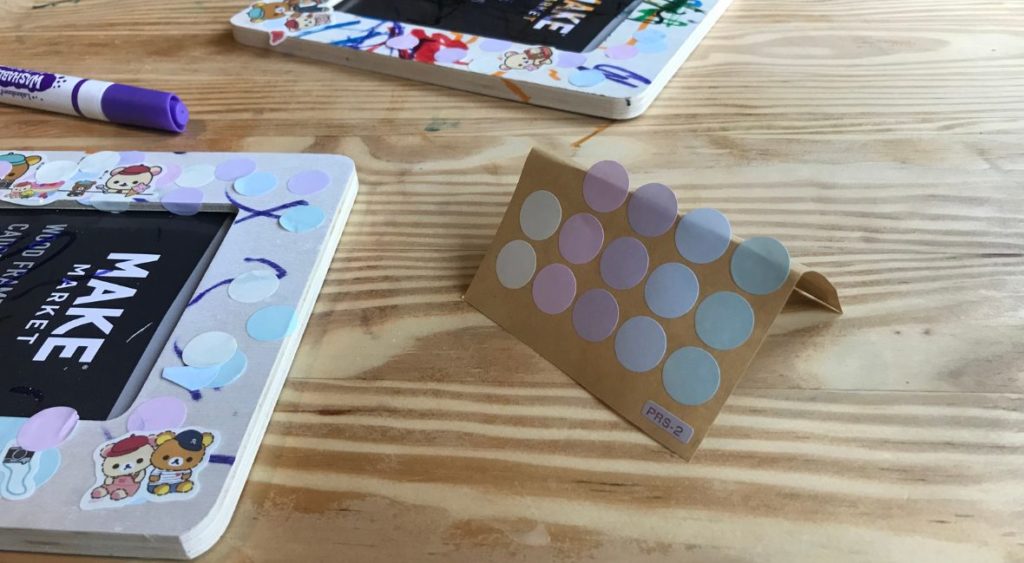
8. Threading Beads
Threading beads requires a surprising amount of coordination! Toddlers can begin with large, chunky beads and transition to pony beads and pipe cleaners as they develop their skills.
Note: beads can pose a choking hazard. Always pick larger beads if your child puts things in their mouth and provide adequate supervision.
- Materials Needed: Beads and a string or pipe cleaner
- Activity: Show your child how to thread the beads onto the string or pipe cleaner and then make the activity available in their playspace
- Benefit: Develops hand-eye coordination and fine motor skills
9. Using Tweezers or Tongs
There are so many simple activities for toddlers using tongs! Test out a few to discover the ones your toddler finds most engaging.
You can simply use a small pair of kitchen tongs or buy some designed for play.
- Materials Needed: Tongs, pom poms, small toys, etc.
- Activities:
- Allow your child to serve their own food using tongs
- Transfer pom poms from a bowl into an egg carton or muffin tin
- Tongs and cotton ball painting: Place cotton balls into bowls of paint. Your child must then pick up the cotton ball and maintain a firm grip on the tongs to paint with it.
- Add tongs to a sensory bin for kids to pick up the larger items placed within the sensory bin filler
- Sorting activities: allow kids to sort things like pom-poms, gems, and colored math counters by color, size, shape, etc., into egg cartons, muffin tins, or colored bowls
- Benefit: Strengthens hand muscles and enhances pincer grasp precision.
10. Playdough Play
Playdough is a classic activity for a reason—kids love it! It’s also excellent for building hand muscles.
You can buy premade playdough or make it with your child. Here is my FAVORITE playdough recipe (and I’ve tried a lot of them).
- Materials Needed: Playdough
- Activity: Encourage your child to pinch, roll, and shape playdough using their fingers and also provide unstructured time for them to use the playdough however they would like
- Benefit: Enhances finger strength and sensory exploration

11. Sorting Small Objects
Sorting activities are so simple and something that kids naturally do!
Giving them access to small interesting items such as math counters, gems, large buttons, toy animals, etc., as well as a variety of bowls and containers, will encourage lots of sorting.
Don’t worry if kids don’t do the activity exactly as you had planned. They’re still manipulating the objects and building their pincer grasp even if they don’t sort them by color, for example. The benefits of self-directed play trump those of adult-directed activities every time!
- Materials Needed: Small objects and bowls, muffin tins, or other containers
- Activity: Allow your child to sort the objects into different containers based on size, color, shape, or type
- Benefit: Develops categorization skills and fine motor precision
12. Lacing Cards
Lacing takes lots of focus and practice since it requires both hands to work together in a coordinated manner while doing different movements. You can begin with a simple lacing card and progress to harder ones as their skills develop.
Offer as much support as necessary when your child is starting, but avoid stepping in with help too soon. They often need much more time than you might think to try it on their own.
- Materials Needed: Lacing cards and laces
- Activity: Show the child how to thread the lace through the holes in the card. Assist as needed and slowly allow them to do more and more on their own
- Benefit: Improves fine motor coordination and concentration
13. Water Play with Sponges
Kids love to play in water, and squeezing is excellent for building hand muscles! Packs of cheap kitchen sponges are perfect for this activity.
- Materials Needed: Sponges and a bowl of water
- Activity: Encourage your child to squeeze the sponge to absorb and release water. Once they have mastered it, step back and let them play however they want.
- Benefit: Strengthens hand muscles and improves grip strength
14. Using Clothespins
There are so many simple and engaging ways to use clothespins with toddlers.
- Materials Needed: Clothespins
- Activities:
- Clip clothespins to the edge of a cardboard box
- Clip clothespins to Megabloks
- Hanging Up the Alphabet Activity
- Benefit: Enhances grip strength and finger coordination.
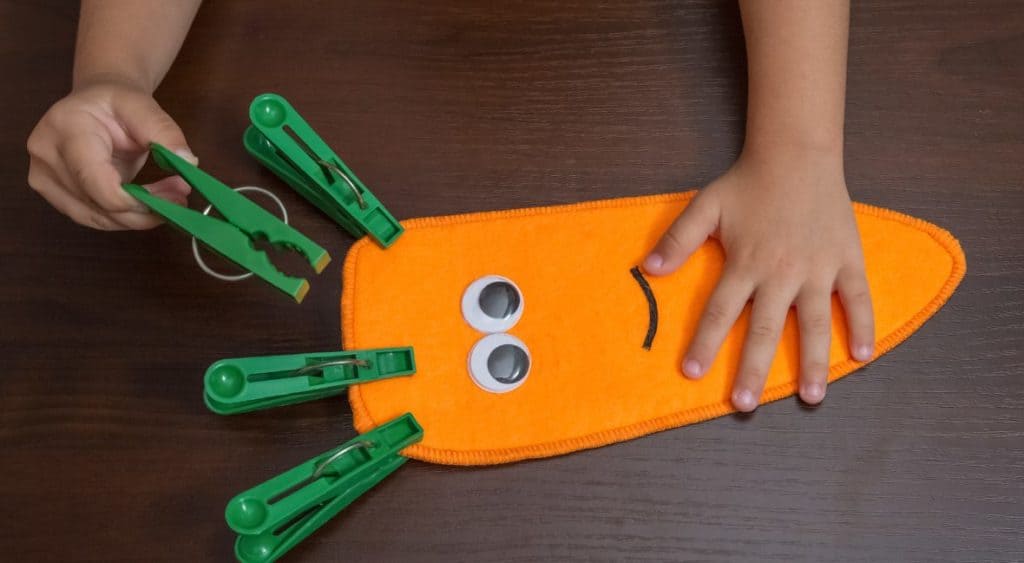
15. Buckling Buckles
Just about every toddler seems to go through a buckling phase! A buckle toy can be an excellent way for them to satisfy that interest and get lots and lots of practice!
In addition, plan extra time to allow kids to help with things like their car seat buckle. This helps kids build confidence and pride in their abilities in addition to just motor skills.
- Materials Needed: Buckle toy and everyday items with buckles
- Activities:
- Allow your child to help with buckles on their highchair, car seat, and stroller.
- Play with a buckle toy: assist your child as they learn to use a toy with buckles, and then allow them lots of time to practice and explore it on their own
- Benefit: Develops finger strength and coordination.
16. Scooping and Pouring
Sensory play can be an excellent way for toddlers and preschoolers to use their hands. You can use a sensory table or add sensory materials to a shallow large plastic bin. Simply add a few scoops and spoons from your kitchen, and it’s ready to go!
Sensory play can get VERY messy very quickly. Have a broom or vacuum on hand, or take the play outside.
- Materials Needed: Small scoops or spoons and containers of water, rice, beans, or sand
- Activity: Provide the child with scoops or spoons to transfer materials from one container to another, pour, mix, and dump
- Benefit: Promotes fine motor control, coordination, and sensory exploration.
17. Playdough Color Mixing
Kids get super excited to see the playdough transform as they mix colors. This excitement drives them to do tons of mashing and squeezing, which builds with their hand muscles.
- Materials Needed: Playdough
- Activity: Have your child pick out two balls of playdough in different colors. Encourage them to squeeze and mash the playdough until they have fully mixed a new color.
- Benefit: Strengthens hand muscles and improves the pincer grasp
18. Picking Blueberries
If you live anywhere near a blueberry farm, take your kids! They will LOVE it.
Kids can wander and pick and eat blueberries for hours. I love watching their pincer grasp develop with each trip. It’s amazing how quickly their skills develop when motivated by a tasty blueberry snack!
- Materials Needed: Trip to the blueberry farm
- Activity: Take along a small bucket and allow kids to wander and pick blueberries
- Benefit: Develops finger dexterity
19. Liquid Water Colors and Pipettes
Pipettes are a fun and engaging way to practice pinching and squeezing. They make the perfect addition to any art area.
- Materials Needed: pipettes and liquid watercolors
- Activities:
- transferring water or liquid watercolors between containers
- dropper painting process art
- squeezing liquid watercolors onto the snow
- Benefit: Promotes hand-eye coordination and fine motor control
20. Peeling Tape
Fact: Toddlers love tape.
And the great thing about blue painter’s tape is that it’s easy to peel off furniture and walls and doesn’t leave a sticky residue.
- Materials Needed: Blue painter’s tape
- Activity: Stick strips of tape onto a low coffee table, walls, or the floor and encourage your child to peel them off and explore the tape however they would like
- Benefit: Improves finger strength and dexterity
21. Using a Hole Punch or Paper Punch
It takes a lot of strength to squeeze a hole punch, but kids generally find it intriguing enough to try and try until they get it.
Kids also love the fun designs of paper punches, which can sometimes be easier for little hands to use.
- Materials Needed: Hole punch or paper punch, paper
- Activity: Simply allow your child to punch holes in the paper using a hole punch and the paper punch
- Benefit: Targets the pincer grasp and strengthens hand muscles.
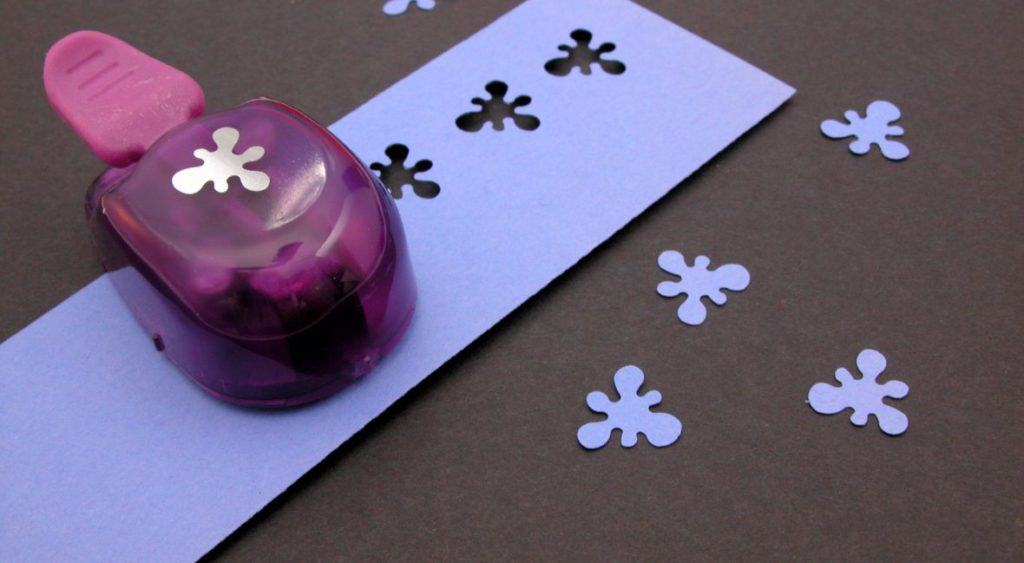
22. Building with Duplose and LEGOs
Building with Duplos or Legos is an excellent way to develop a pincer grasp, muscles, and coordination. I love that kids must use some force to push the blocks together.
Opt for simple buying pieces instead of specific sets. This allows for many more possibilities as kids can be creative and build whatever they want.
Begin with Duplos and only switch to LEGO pieces when your child is no longer mouthing toys.
- Materials Needed: Duplo locks or LEGO bricks
- Activity: Encourage your child to build with the pieces
- Benefit: Promotes fine motor skills and hand-eye coordination.
23. Squeezing Glue Bottles
Glue bottles are one of my favorite tools for helping kids build their hand strength!
Kids love it when they’re allowed to squeeze lots and lots and lots of glue. Instead of seeing wasted glue and attempting to limit kids, remind yourself of all the skills they’re building: hand muscles, concentration, curiosity, creativity, understanding of cause and effect, self-direction, etc.
- Materials Needed: Glue bottles and paper
- Activity: Allow the child to squeeze as much glue onto paper as they like!
- Benefit: Enhances hand strength and precision.
24. Buttoning and Unbuttoning
Buttoning is an essential life skill requiring finger dexterity and coordination between the two hands.
Kids can practice buttoning as they dress and undress themselves or through play activities.
- Materials Needed: clothes with buttons, button board, large buttons
- Activities:
- Begin by having your child practice unbuttoning their clothes and then move on to buttoning as their skills develop
- Cut slits in pieces of felt and have your child push buttons through
- Practice with button boards
- Benefit: Improves finger dexterity and self-care skills.
25. Zipping and Unzipping
Zipping requires kids to use a pincer grasp because this is the only way to hold onto a small zipper pull. It’s also a much-needed life skill that helps kids feel independent and capable.
Zipping a jacket requires several steps, but kids can begin by simply zipping up the coat while you hold the button. A zipper bag can also be great for zipper practice.
- Materials Needed: Clothing with zippers, bags with zippers
- Activity: Allow the child to zip and unzip their jackets or bags. Support them as much or as little as needed.
- Benefit: Enhances hand coordination and independence
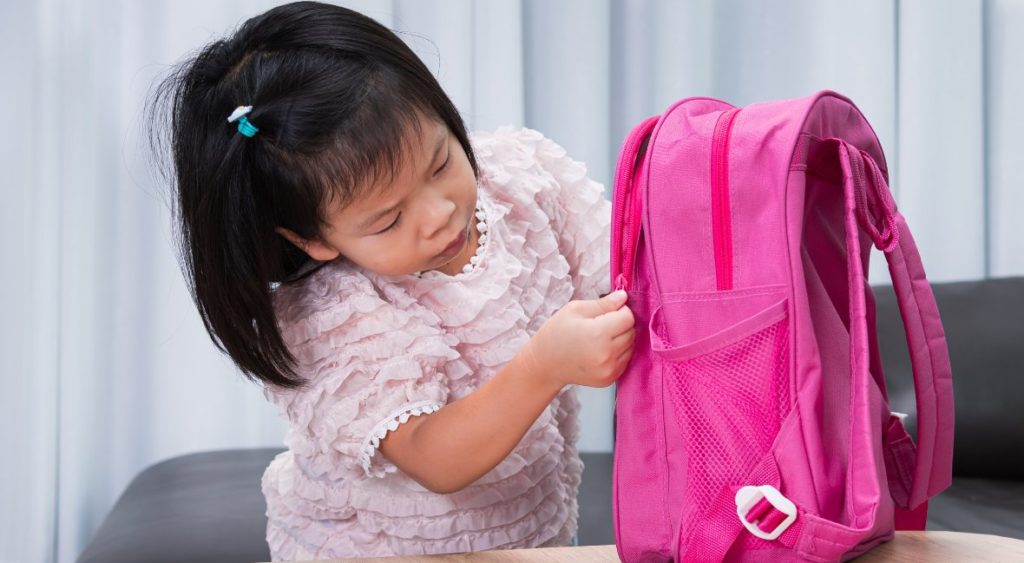
26. Tearing Paper
Tearing paper is surprisingly satisfying and great for developing pinching fingers. I also love how simple it is to set up!
You can have kids help recycle all the paper or save it for process art collages when they are done ripping it up.
- Materials Needed: Old magazines, newspapers, or scrap paper
- Activity: Demonstrate for your child how you pinch the edge of the paper and tear it into small pieces. Allow them to rip and tear
- Benefit: Strengthens finger muscles and improves fine motor control
27. Using a Spray Bottle
Toddlers love to have their very own spray bottle with water! This is an excellent outdoor activity to keep kids engaged and build those hand muscles.
- Materials Needed: A small spray bottle filled with water
- Activity: Let the child spray water onto plants, anywhere outside, or to help clean surfaces
- Benefit: Develops hand strength and coordination.
28. Stringing Pasta
What’s so great about playing with pasta? Well, you probably already have some in your pantry, so there’s no need to buy additional things.
- Materials Needed: Uncooked penne pasta, skewers, straws, pipe cleaners, string
- Activity:
- Easiest: Stick wood skewers into styrofoam packing. Thread pasta onto the skewers.
- Bit Harder: Thread the pasta onto straws or pipe cleaners
- More Advanced: Thread the pasta onto a string with a taped end to create a pasta necklace
- Benefit: Enhances hand-eye coordination and fine motor skills.
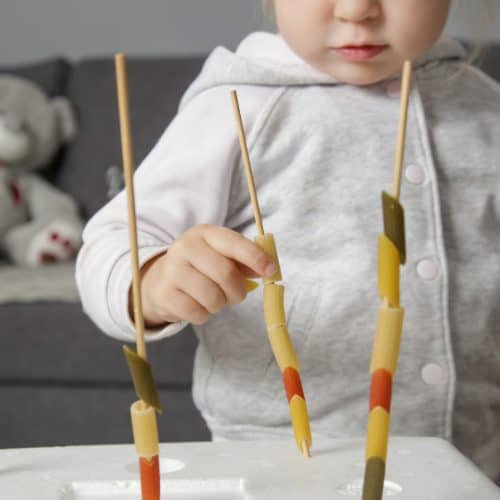
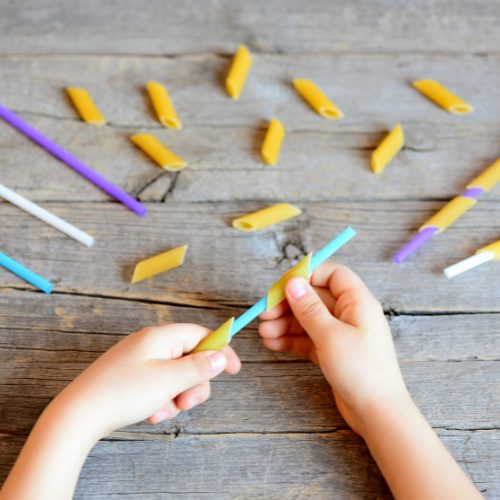
29. Opening and Closing Containers
Here is another simple activity that utilizes kitchen items to build motor skills. Toddlers will work hard to master the ability to get lids on and off containers.
- Materials Needed: Small containers with lids, such as Tupperware or jars
- Activity: Encourage your child to practice opening and closing the containers or simply make them available in the playspace
- Benefit: Strengthens hand muscles and coordination
30. Using a Spoon and Fork
Utensils provide great fine motor practice and foster independence and an “I can!” confidence. Allow your child to feed themselves so that they can practice every day.
- Materials Needed: Child-size spoon and fork
- Activity: Simply provide a fork and spoon at each meal and model eating with your own fork and spoon.
- Benefit: Enhances fine motor skills and independence
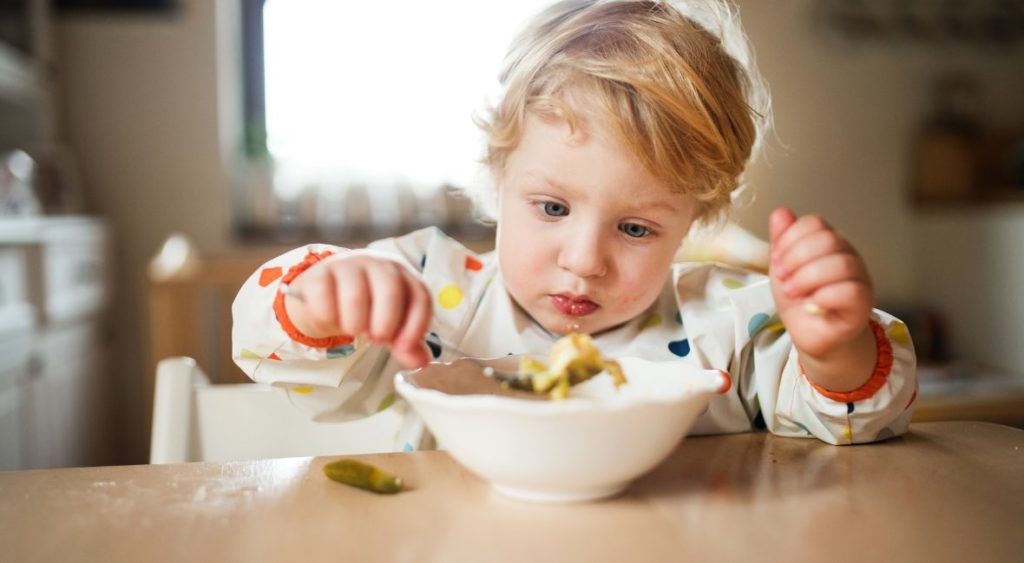
31. Peeling Fruit
Babies and toddlers love to help with everyday tasks. Peeling fruit is a great way to include them and build their finger dexterity.
Kids are pretty motivated to work on a task when there’s a snack involved!
- Materials Needed: Bananas and oranges
- Activity: Allow your child to peel the fruit themselves or help you as much as they are able
- Benefit: Strengthens the pincer grasp and improves self-care skills
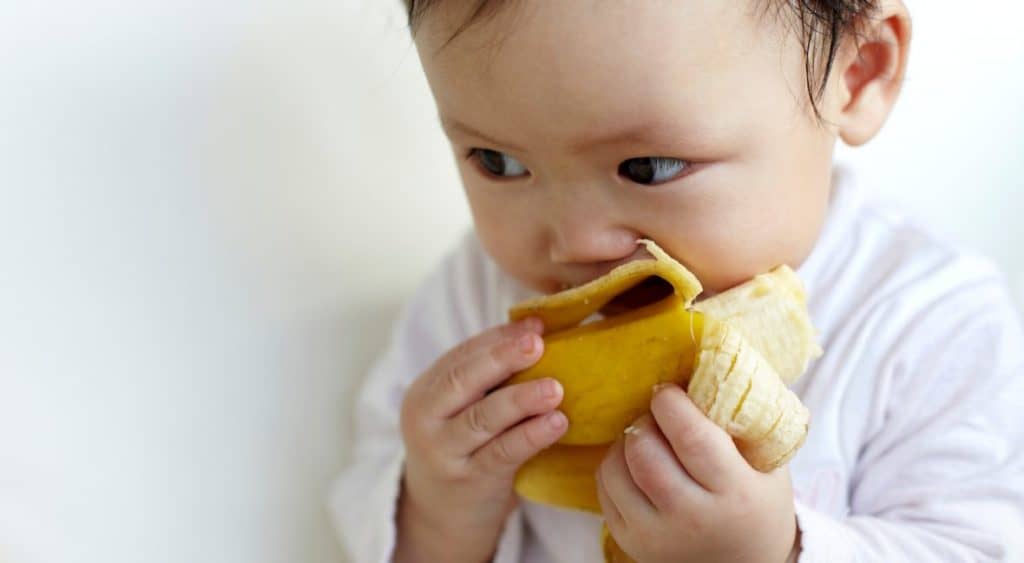
32. Stringing Cheese
Simple, yet effective! Let kids pull string cheese apart to help them develop their fine motor skills through daily activities.
- Materials Needed: String cheese
- Activity: Let your child pull apart the string cheese into small pieces
- Benefit: Enhances finger strength and dexterity
33. Pipe Cleaners into a Colander
Here’s another simple activity using something you already have at home: a colander. Add a few pipe cleaners, and your child is ready to play!
- Materials Needed: Pipe cleaners, colander
- Activity: Kids can stick the pipe cleaners into the holes of the colander
- Benefit: Develops finger strength and coordination
34. Coloring with Mini Crayons
People often think of big, chunky crayons for toddlers, but those actually encourage little ones to use their whole fist to grip them. Instead, use mini crayons!
Because of their size, mini crayons must be held with the thumb, pointer, and middle finger, making them perfect for developing a pincer grasp!
You can buy mini crayons or simply break regular crayons in half.
Note: Mini crayons can be a choking hazard. Always provide adequate supervision.
- Materials Needed: Mini crayons, paper
- Activity: Give your child lots of opportunities to color with the crayons
- Benefit: Improves hand-eye coordination and fine motor skills
35. Playing with a Tape Measure
Did you know that there are tape measures for kids? Tape measures make a pretty novel toy that can begin to build kids’ numeracy skills.
Kids can develop their pincer grasp by pulling out the tape measure and using the crank to retract it.
- Materials Needed: Tape measure
- Activity: Show the child how to extend and retract the tape measure and then let them explore with it
- Benefit: Enhances fine motor control and coordination.
36. Button Trees
Buttons trees are another great variation on beading and lacing activities that kids love! I use them in preschool classrooms all the time.
- Materials Needed: Pipe cleaners, large buttons, bowl, tape
- Activity: Twist together some pipe cleaners and tape them into a bowl to make a “tree.” Allow kids to push the buttons onto the pipe cleaner trees.
- Benefit: Enhances fine motor skills and precision.

37. Lock and Key Toy
Keys and locks make excellent toys requiring lots of focus and coordination.
I love house toys with locks that kids must open to play.
- Materials Needed: Lock and key toy
- Activity: Allow the child to practice unlocking and locking the toy as they play
- Benefit: Strengthens hand muscles and improves fine motor coordination
Tips for Encouraging Pincer Grasp Development
- Make it Fun: Choose enjoyable and engaging activities for your child to keep them motivated.
- Be Patient: Developing fine motor skills takes time and practice. Plans lots of unstructured time for kids to play.
- Integrate Activities into Daily Routines: Incorporate pincer grasp activities into everyday tasks, such as mealtime, playtime, and chores. Allow lots of time for kids to do things themselves, such as dressing and eating.
- Provide Variety: Offer a range of activities to keep things interesting and target different aspects of fine motor development.
- Encourage Independence: Allow your child to attempt tasks independently, offering assistance as needed to build confidence and self-reliance.
Final Thoughts
Developing a strong pincer grasp is crucial for young kids’ fine motor skills and overall development. By incorporating engaging and playful activities into their daily routines, you can help kids strengthen this essential skill.
Remember, the key is to make these activities fun, allowing kids to practice and develop their pincer grasp in a supportive and encouraging environment. Through consistent practice and various activities, kids will gain the skills and coordination needed for tasks they will encounter as they grow.
By embracing the power of play, we can support our kids’ development and set them up for success in all aspects of their lives.










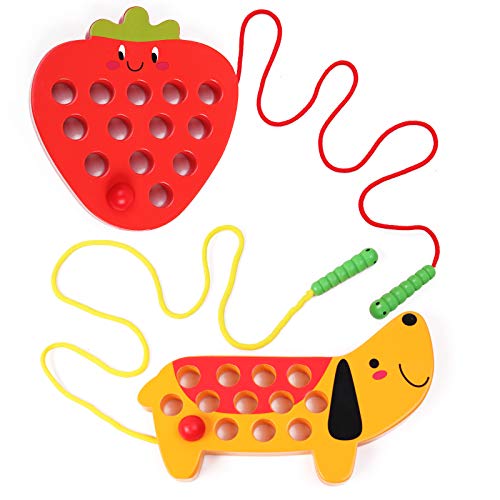






![Washable Liquid School Glue [Set of 3] Size: 1.25" H x 2.5" W x 5.75" D](https://m.media-amazon.com/images/I/5165qcqBskL._SL500_.jpg)






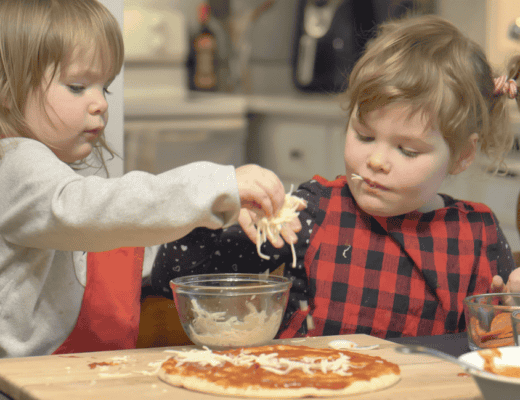
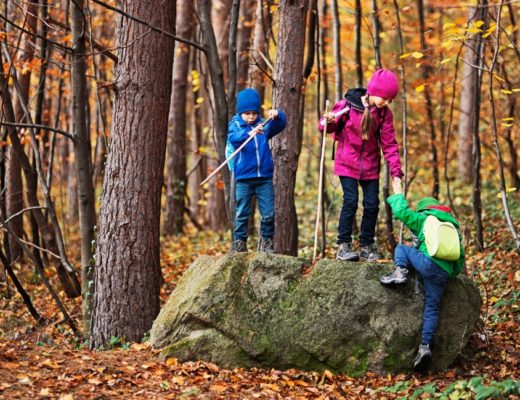


No Comments